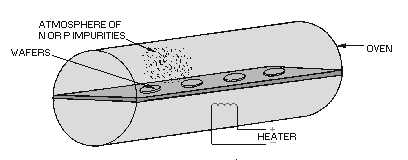1-12
Q21. Describe the preparation of a silicon substrate.
FABRICATION OF IC DEVICES
Fabrication of monolithic ICs is the most complex aspect of microelectronic devices we will discuss.
Therefore, in this introductory module, we will try to simplify this process as much as possible. Even
though the discussion is very basic, the intent is still to increase your appreciation of the progress in
microelectronics. You should, as a result of this discussion, come to realize that advances in
manufacturing techniques are so rapid that staying abreast of them is extremely difficult.
Monolithic Fabrication.
Two types of monolithic fabrication will be discussed. These are the DIFFUSION METHOD and the
EPITAXIAL METHOD.
DIFFUSION METHOD.—The DIFFUSION process begins with the highly polished silicon wafer
being placed in an oven (figure 1-11). The oven contains a concentration impurity made up of impurity
atoms which yield the desired electrical characteristics. The concentration of impurity atoms is diffused
into the wafer and is controlled by controlling the temperature of the oven and the time that the silicon
wafer is allowed to remain in the oven. This is called DOPING. When the wafer has been uniformly
doped, the fabrication of semiconductor devices may begin. Several hundred circuits are produced
simultaneously on the wafer.
Figure 1-11.—Wafers in a diffusion oven.
The steps in the fabrication process described here, and illustrated in figure 1-12, would produce an
npn, planar-diffused transistor. But, with slight variations, the technique may also be applied to the
production of a complete circuit, including diodes, resistors, and capacitors. The steps are performed in
the following order:

